Islanders at the turn of the century didn’t wait until Halloween to enjoy ghosts. Ghost parties and ghost dances were popular during the summer months at the turn of the nineteenth century. At a “Spook Social,” the sheet-wearing attendees had a number pinned to them when they arrived. The ghosts then mingled and tried to guess the identity of the other ghosts–not by the detection of their voices—but by their sheet-covered shapes alone. The ghost who correctly identified the other ghosts in the room won a prize.
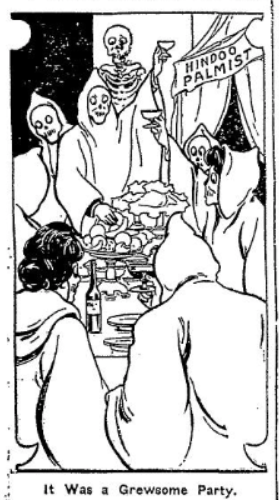
A 1906 spook party was described like this: “The guests are invited to come as spooks and dress in a manner to suggest that they have just arrived from a spirit world. The hostess says that she will be the real thing in ghosts and that her guests will be surprised when they see her. A feature of the occasion will be the after-dinner speeches, when all present must relate a personal experience which seems supernatural, or if they haven’t had one, they must quote some friend who had a friend who had.”
Other activities at spook parties included a Silhouette Contest and a Cheshire Cat Contest. I can only imagine what these games entailed. Perhaps a silhouette contest meant guessing the backlit silhouettes of party-goers? And maybe the Cheshire Cat Contest would mean guests had to identify a person from their smile only?
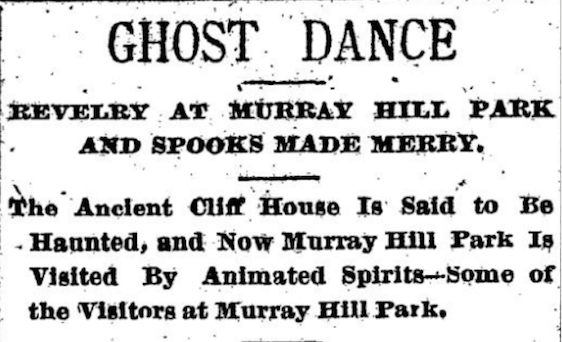
In 1893, Murray Hill Park held a Ghost Dance in the newly erected boathouse at Oak Point. The Murray Hill Park Hotel was still a few years off; the boathouse was the first structure of the complex completed. The second floor of the boathouse was a lovely ballroom. The party was hosted by Mr. Corbin, who hailed from nearby Gouverneur, New York. Mr. Corbin was the president of the Thousand Islands Investment Company, which had purchased most of what had been called Hemlock Island and recently renamed Murray Hill Park. By all accounts, Mr. Corbin was an excellent master of ceremonies. The event was described as “teeming with merriment from the rise to the fall of the curtain, from the first to last scene as the accomplished dancers performed their graceful evolutions in all the new and intricate figures of the Terpsichorean art, in perfect time to several instruments operated by skillful hands.” (Terpsichorean, by the way, is just a fancy way of saying dancing. Newspapers of the late nineteenth century seemed to cater to a higher reading level than they do today.)
What kinds of refreshment does one serve at a 1890s Spook Party? I wasn’t surprised to see popcorn balls or pie on the list of refreshments but fried oysters? Really? At the Murray Hill Park Dance, “Mr. J. C. Lee furnished for the occasion a hogshead of ice-cold lemonade, the beverage which exhilarates, but not intoxicates.”
Shoreline Ghost Dances
I also found several references to “ghost dances” being performed for the Searchlight Excursions. Several steamship lines had night excursions with a powerful searchlight that would shine on various points of interest as it cruised through the islands after nightfall. The first ghost dance I came across was back in 1892, when the steamer St. Lawrence was passing Rockport, Ontario. The bright rays of the searchlight illuminated several figures draped in white “going thro’ the fantastic movements of a ghost dance in true Indian style.” The performers were presumed to be a number of Brockville boys who were camping at that place.
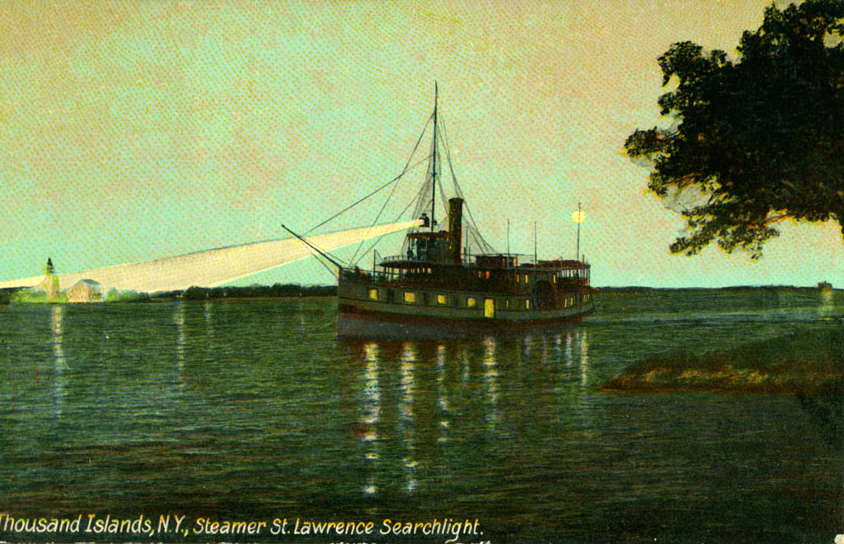
Not to be outdone, I found this 1895 article titled “Dance of the Sprites,” about my own dear Grenell Island. When the steamer St. Lawrence swung the searchlight toward the Grenell Island store dock, “a weird and awe-inspiring spectacle flashed into view. At the water’s edge danced a band of sprites robed in spotless white and with features of a ghastly paleness. They did not utter a sound, but in the wild light of the electric eyes they flitted noiselessly through the mazes of ethereal measures.” Just when the passengers aboard the St. Lawrence thought they might be viewing real sprites, the dancers broke into a “peel of silvery laughter that told they were flesh and blood, and not inhabitants of another world.”
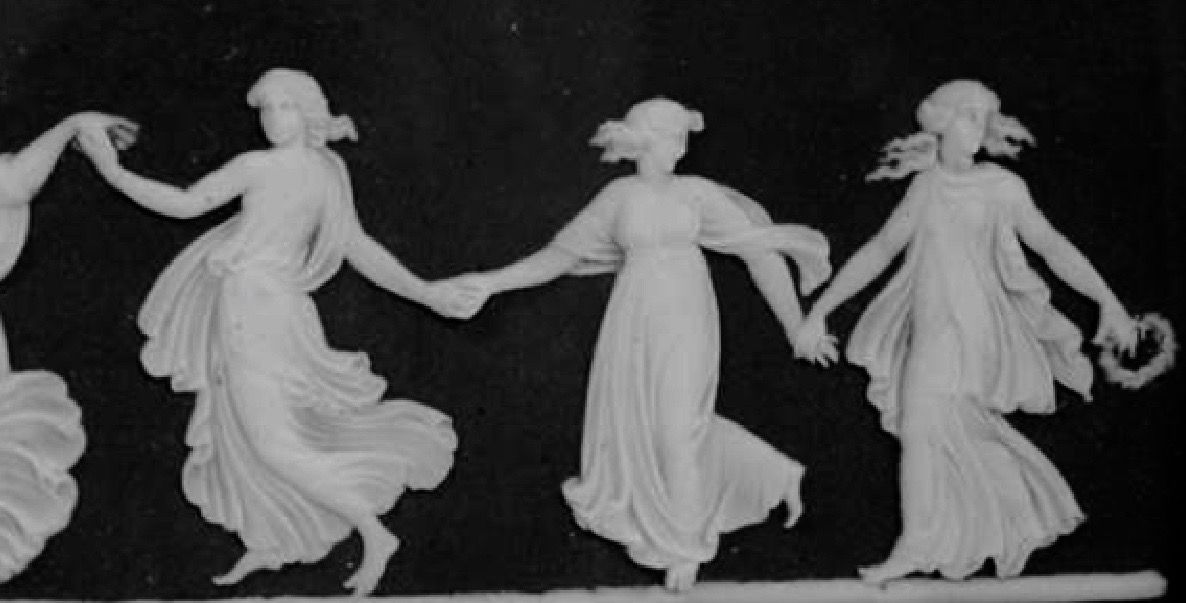
Who were the Grenell sprites? The article only says that “the idea of masquerading for the benefit of the searchlight people had been suggested by one of the brightest of the ladies who are summering here, and once broached had been seized upon with a will by the others. Pillow shams, sheets, and flour were quickly secured, and the result was more than had been anticipated.” About 30 ladies took part in Grenell’s “Dance of the Sprites.”
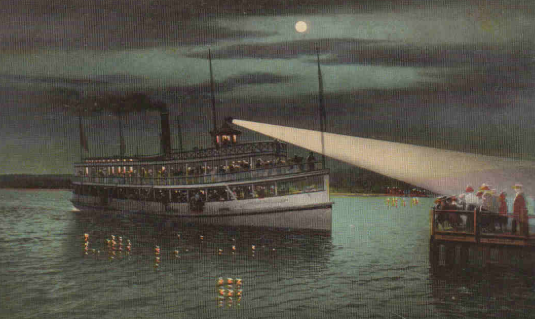
A Real Ghost Story...?
But what would a ghost or spook party be without a good ghost story to round it out? I leave you with this tale which was first told in print in On the St. Lawrence in 1891 but tells of a supposedly true tragedy that happened forty years before—back in the 1850s. I found yet another version in a 1916 Postdam Courier and Freeman article. I combined the two accounts here. The main character of the story is a man named Pete. The 1891 version said his last name was Lair, but the 1916 version said his last name was Ware. Both versions agreed that Pete was a good for nothing outcast, who saw himself as a bit of a ladies’ man.
As our story begins, Pete is working for a lumber company that owned a tract of forest lands on Grindstone Island along the shore of Eel Bay. The superintendent of the lumber company lived on Grindstone with his lovely wife who cooked meals for the employees. Pete did not endear himself to his workmates. He was constantly flirty with the young woman and always being rewarded for his efforts with the largest slice of pie. Being a bit of a cad, Pete convinced the wife of his boss to forsake her husband and elope with him. Pete waited until his boss was away one evening then stole one of the company’s boats. He not only stole away his boss’s wife but also his Newfoundland dog. Seems the runaway wife didn’t travel lightly. She insisted that she take with her a large chest of household goods and her cookstove. Once the boat was loaded, they stole away into the night paddling toward Clayton where the two intended to take a steamer west.
A violent storm arose that night, and the small boat loaded with two people, a large dog, a chest of household goods and a heavy cook stove was quickly swamped. Somewhere near the head of Bluff Island, the boat capsized. Pete and the runaway wife were drowned. The dog swam ashore to the little bay at the head of Robbin’s Island. (Locals now refer to this bay as Bath Tub Bay at the head of Picton Island.) Three days later, hunters heard a howling dog in distress and found the Newfoundland dog guarding the body of his mistress. Her body was buried there on the shore.
[An interesting aside, I discovered reading the two versions of the same story that back in the early 1800s, it was considered unlucky to move the bodies of drowning victims and they were often buried close to where they were found.]
Pete’s body drifted ashore at Mason’s Point on the mainland, below Round Island and was buried where they found the body, on the sand beach there. For many years, superstitious people avoided Mason’s Point after dark—especially if they were alone—as it was reported that Pete’s ghost had been seen dragging the cookstove up and down the sandy beach.
And what about the poor husband who lost his wife? As the story goes, the husband didn’t grieve too much. Reportedly, he said that his only regret was the loss of the cookstove. After all, he did get his dog back.
Happy Halloween!
By Lynn E. McElfresh, Grenell Island
This month Lynn discovered ghosts! Have you heard of ghost stories too?
Lynn McElfresh came to Grenell Island for the first time to meet her fiancé’s family, in 1975. She became part of the family, and the island became part of her life. Lynn and her husband, Gary, spend their summers in the Thousand Islands and their winters in Dunedin, Florida. To see all of Lynn’s 131 (yes 131!) island experiences, search TI Life under Lynn McElfresh.
And in August we announced Lynn's first of nine novels... Grenell 1881, now on sale in several River locations. See our TI Life Review and... buy it, read it and enjoy it!
Plus... Log on to Lynn's Facebook page Thousand Islands Series... you will not be disappointed.
Posted in: Volume 14, Issue 10, October 2019, Places, History
Please click here if you are unable to post your comment.
